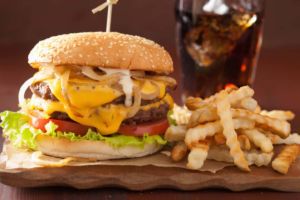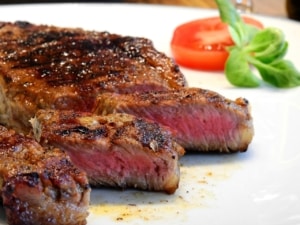The Dirty Bulk: Five Reasons To Do A Clean Bulk
August 26, 2021
Of all the dumb fitness ideas out there, the dirty bulk is one of the dumbest. That may seem like an extreme statement, but trust me on this one.
After all, I used to guzzle weight gainers mixed with ice cream until I grew a FUPA and had more stomach rolls than abs.
Following a dirty bulk will leave you fat and frustrated, not jacked and confident.
The problem is that a dirty bulk involves eating as much as you can. You devour calories like a malnourished hyena.
When you follow a high-frequency muscle building program, you DO need extra calories to build muscle there’s only so much your body can handle.
When you eat with reckless abandon you’ll be rewarded with a set of love handles and man boobs, not bolder shoulders and defined arms.
Isn’t it to look better naked?
To feel strong, confident, and powerful?
You want to be “that guy.”
You want a body that earns the respect of others and, most importantly, fills you with confidence.
You want to avoid the dirty bulk bitch tits. You want to build a strong, lean, and muscular body.
Here are the top five reasons to avoid the dirty bulk.
1. Dirty Bulk Downgrade: Caloric Spillover
Calorie balance is still king when it comes to building muscle. If you’re going to put on lean muscle, you need to be in a caloric surplus.
Calories In: Calories from food.
Calories Out: Calories used for daily activity and bodily function.
Caloric Surplus: When you take in more calories than your body burns each day.
Seems simple, right? Well, it is. Problems arise when you fall into the trap of believing more is always better.
Too many lifters are misled by the diets of professional bodybuilders. They try the same ideas without the chemical enhancement (steroids) to back it up.
This is a huge problem for the natural lifter. Steroids allow a user to drastically increase protein synthesis. This makes it much easier to eat an excessive number of calories and use them directly to accelerate muscle growth.

While a bodybuilder may be able to eat a caloric excess of 1,000 calories and gain insane amounts of muscle, the same plan applied to a natural lifter only leads to a main course of body fat, with a side order of subpar muscular gains.
Like it or not, there’s a limit to how fast you can build muscle as a natural lifter. I’ll dig into how much you need to eat below.
But for now, understand a surplus of 300-500 calories is all you need to maximize muscle growth.
2. Dirty Bulk Downgrade: Fat Hyperplasia
When you overeat, your body increases the number of fat cells your body stores. It’s a survival mechanism. This is called fat hyperplasia, and it makes it more difficult to lose fat going forward.
The big kicker here is you can’t eliminate cells. You can only make them smaller. When you follow a dirty bulk you’re increasing the number of fat cells in your body. You’ll gain weight in the short term while also making it easier for your body to store fat in the future.
The result? You get stuck in permabulk mode. You gain more fat than muscle. And you may have one hell of a time getting ripped once beach season comes around.
3. Dirty Bulk Downgrade: Decreased Insulin Sensitivity
At any given moment you’re either burning fat or building muscle.
The switch behind this? Insulin.
Insulin stimulates protein synthesis, inhibiting the breakdown of protein, and is an extremely powerful muscle-building hormone.
 If you’re a naturally skinny guy like I am, having a high insulin sensitivity is one of the best weapons in your arsenal. When you’re sensitive to insulin, your body effectively burns stored body fat and breaks your food into energy. Better yet, it’s easier to build muscle without getting fat.
If you’re a naturally skinny guy like I am, having a high insulin sensitivity is one of the best weapons in your arsenal. When you’re sensitive to insulin, your body effectively burns stored body fat and breaks your food into energy. Better yet, it’s easier to build muscle without getting fat.
When you’re overweight and have a gut to lose you’re not sensitive to insulin. Heck, most people aren’t and it’s damn-near impossible to add lean muscle without adding a spare tire on the side.
Instead of the classic dirty bulk, you want to play the long game and add muscle slowly. This allows you to maintain higher insulin sensitivity and keep fat gain to a minimum.
Nutrition partitioning is how well you break down your carbs, fats, and proteins into usable glucose, fatty acids, and amino acids. It is related to your genetics, hormones, and yes, your insulin sensitivity.
4. Dirty Bulk Downgrade: Poor Nutrition Partitioning
When you gain body fat and decrease insulin sensitivity from mindless eating during a dirty bulk, you impair your body’s ability to break down food into its usable parts.
The result? It becomes easier to gain fat and more difficult to build lean muscle.
5.Dirty Bulk Downgrade: You’ll Develop Shitty Habits
Raise your hand if you know a lifter who’s always bulking.
More often than not, these folks stay in the permabulking stage. They look like they lift, but they’ve got extra flab and look a wee bit out of shape. There’s nothing wrong with this as many of these guys are very strong. I value strength, but I also value my health and looking good naked (at least according to my wife.) ????
When you use #bulking as an excuse to gorge on pizza, ice cream, and eat with the discipline of a small child you’re going to develop shitty habits.
Eventually, you’ll have to pay the piper. The bill will be long-term health issues, an increase in body fat, or both.
I’m all for living a life that’s improved, not consumed, by fitness. I like to have a few drinks, steaks, and pizza myself. But moderation is key, even when you’re building muscle.
Keep your eye on the ball.
Play the long game.
Death To The Dirty Bulk (and the birth of the Clean Bulk)
There’s a limit to how quickly you can build muscle. The work of Alan Aragon and Lyle McDonald suggests the maximum rate of muscle growth appears to cap off around 40-50 pounds over the course of a lifetime.

The amount of muscle you can build decreases dramatically as you gain age and experience in the gym. Though some fat gain and water weight is inevitable, gaining more than a few pounds per month is a solid indication you’re consuming too many calories.
How Many Calories You Need To Build Muscle
To maximize your gains without getting fat you need a slight caloric surplus. To get started, calculate maintenance calories. I’ve tried half a dozen of equations and they’re all pretty close. Plus, they’re all estimations, so ease of use is important.
My go-to equation is this: Bodyweight (pounds) x16= Maintenance for someone moderately active (trains 3-4x per week)
150 lbs x16= 2400 calories for a 150lb, moderately active person.
From here, you’ll want to add another 300-500 calories to get into a slight caloric surplus to trigger muscle growth. I use the higher end on training days and the lower end on rest days.
On the days you workout you’ll have 2900 calories. On non-lifting days have 2700 calories.
In real food, this comes out to 1-2 protein shakes and a banana or two per day above maintenance calories. Alternatively, this is an extra sweet potato and a chicken breast each day.
It’s not a 1200 calorie burger meal from the fast-food joint!
How Much Protein Do You Need to Build Muscle?
You need sufficient protein to build muscle, though it’s not as much as supplement companies would have you believe.
All you need is .82g/lb. -1g of protein per pound of bodyweight.
This means a 160lb guy needs 131g-160g of protein per day. Can you have more? Sure, but a 2011 study by Phillips and Van Loon found .82g/lb. of bodyweight to be the upper limit of protein synthesis.
In other words, eating more protein won’t increase how much muscle you’ll build.
This means our 150 lb dude needs 123-150g of protein per day to build lean muscle. IF he’s getting his calories, more protein won’t lead to more muscle growth.
Protein has 4 calories per gram, means you’ll have 492 to 600 calories from protein.
How Many Carbs Do You Need to Build Muscle?
Most people hopped on the low-carb bandwagon at some point. These diets work well for fat loss, but not for building muscle.
Here’s the problem. Carbohydrates are protein sparing. This means eating carbs will spare your body from breaking down stored muscle tissue to fuel your day.
Eating a moderate-high carb diet helps you keep the lean muscle you’ve already built rather than breaking it down for energy.
Further, your workouts will suffer during a low carb diet. You’ll be lethargic and have terrible pumps. You’ll end up flat and deflated, not pumped and jacked.
Carbs are your friends. They’ll spare the muscle you have, improve your workouts, and help drive nutrients into your cells to maximize lean muscle gains.
Eat 1.5-2g of carbs per pound of bodyweight to maximize lean muscle growth. This means 225g-300g of carbs per day.
Carbs have 4 calories per gram, means you’ll have 900-1200 calories per gram.
Fat Intake For Muscle Growth
Fat, the most calorically dense macronutrient, has 9 calories per gram. You need ample fat intake to optimize hormones, brain, and nervous system function. The remaining of your calories will come from fat.
Let’s use our 160 lb lifter as an example.
Lifting Day: 2900 calories Protein:160g/640 cals Carbs: 300g/1200 cals
2900-640-1200= 1060 calories remaining
1060 calories/9 cals/gm= 118g of fat per day.
Demystifying The Dirty Bulking
Dirty bulking appears attractive. But the promise is false. The sad reality is that dirty bulking will slow down your progress because it adds more fat you’ll need to lose later, while significantly slowing down your ability to build muscle.
When in doubt, take the long road. It will end up being faster.
Eat slightly more than you need to build lean muscle.
And most of all, be patient. It takes time to build muscle.
Play your cards right by sticking to the basics. You’ll build a strong, lean, and muscular body.











Great article and all, thank you. Understanding the situation of a true hardgainer/ectomorph/blazing-furnace-metabolism is really important too though. .
I agree, that’s why I wrote the article to help you out 🙂
Hi Eric, thanks for this article. I was wondering if these equations are the same for women who are trying to develop lean muscle (not bulk up, just get sexy ripped :-)!)
Thanks!
Jen
Hey Jen, yes they are!
[…] Source link […]